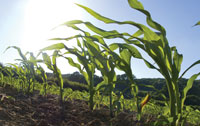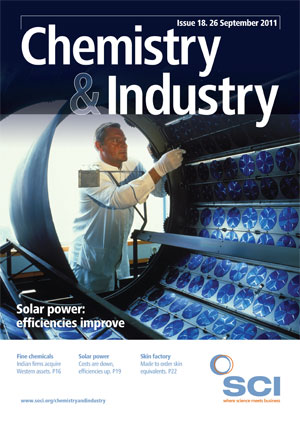Janet Allen, director of research at the UK funding body BBSRC (Biotechnology and Biological Sciences Research Council) says that even a small change to the efficiency of photosynthesis will make a huge impact on food and energy problems. The council recently joined forces with the National Science Foundation (NSF) in the US to tackle this crucial task.
The challenge
A ‘villain’ of photosynthesis efficiency is rubulose- 1,5-biphosphate carboxylase/oxygenase, aka ‘rubisco’. Considered the most abundant protein on Earth, rubisco is a key enzyme in the fixation of carbon dioxide in plants. But it is inefficient – only 50% or so is saturated by the substrate CO2 under most conditions and it fixes both CO2 and oxygen. The oxygenase reaction results in a loss of carbon, in the process known as photorespiration.
Why is rubisco so wasteful? The conventional explanation is that when rubisco evolved 3.6bn years ago it was swamped by CO2, with almost no oxygen in the atmosphere, and there was no demand to distinguish between the gases. But the success of rubisco sucked CO2 out of the atmosphere and bumped up oxygen levels so that the situation has reversed.
There have been efforts to improve rubisco, but to no avail. ‘There seems to be an incompatibility for rubisco to get better at distinguishing between CO2 and oxygen, and its speed of reaction. If it gets better at getting CO2, it slows down,’ says Julian Hibberd of the University of Cambridge, UK, who is investigating ways of improving photosynthesis. Evolution recognises rubisco’s limitations and has worked around the problem. Two innovative ways to do photosynthesis – the C4 pathway and CAM photosynthesis – have evolved in different lineages of plants. Both involve upping carbon dioxide levels around rubisco, which can lead to a 50% productivity rise in some plants like maize that use the C4 pathway.
Taking this lead from nature, four ambitious research projects are setting out to boost photosynthesis and start a new green revolution.
Thinking outside of the box
In September 2010, scientists, from widely differing fields, met in an ‘ideas lab’ in Asilomar, California, US, to stimulate thinking in under-developed research areas relevant to photosynthesis. The NSF and BBSRC had facilitators on hand to encourage innovative ideas on how to enhance photosynthesis. ‘The idea was to challenge someone to think differently about something they’d looked at for perhaps their whole life’, explained Lee Cronin, who heads a chemistry group in the University of Glasgow, Scotland, and was one of the participants at the Asilomar meeting. As a result, four projects, involving collaborations between labs in the UK and the US, emerged. They are all high risk, but potentially high return, projects.
Plant scientist Mike Blatt of the University of Glasgow is collaborating with Hibberd in Cambridge, along with researchers in Warwick University, in the UK; Penn State University, US; and the University of California, Berkeley, US, on the MAGIC project – multi-level approaches for generating increased CO2. Blatt sums up the project: ‘It’s all about making sure rubisco is not swamped with oxygen.’ The underpinning strategy relies on the design of a two-stage pump. A transport mechanism will concentrate bicarbonate (HCO3-) in the chloroplast, powered by a light-driven ion pump from the primitive bacteria Halobaterium halobium. An assembly line of proteins will be built to capture carbon entering the chloroplast and deliver it directly at the active site of rubisco. Hibberd, who will focus on the metabolite channelling, says they are looking for transferable technology that can be modelled in the plant Arabidopsis and then placed in crops to improve yields. It is different from what a C4 plant does, he explains, but has the potential to deliver a 50% increase in productivity.
Rubisco’s tendencies might be a drag on terrestrial plants, but aquatics have added difficulty. They face a 1000-fold greater resistance to diffusion of CO2 through water compared with air, says Andrew Smith, a plant scientist at Oxford University, UK. ‘Aquatic plants typically also have CO2-concentrating mechanisms to help CO2 reach the enzyme rubisco,’ he explains.

Researchers on CAPP aim to characterise the pyrenoid and ultimately transfer elements of it to crops. The rubisco is packaged tightly only when CO2 is low in abundance and Griffiths says that the small subunit of the enzyme seems to hold the key. A successful outcome in crops may be some way down the road, says Griffiths, but it may prove possible to move this carbon concentrating system into every chloroplast in a plant. A third project will look to engineer protein structures from blue-green algae into crop plants to minimise photorespiration and boost yields.
Meanwhile, Cronin’s chemistry group is focusing on molecular fundamentals, inorganic biology, synthetic systems and hybrid devices. ‘In the photosynthesis project, we really wanted to ask a simple question: how can we get beyond the bottleneck which exists right now, which is the activation of carbon dioxide,’ he explains. ‘We want to get around rubisco if we can.’
The project – Plug and Play Photosynthesis – aims to separate the capture and conversion of solar energy into fuel into two different organisms that would communicate with one another via electrical currents. ‘Our idea is to take phototrophic bacteria, which are very good at harvesting light, and plug them into heterotrophic bacteria via a conducting wire. The heterotroph is basically the metabolic engine which we would input the energy into in the form of electrons or an electric current that would then be used to activate CO2 or some other related intermediate to store the light energy in carbon and hydrogen bonds, producing a new approach to get liquid fuels from biology beyond the current carbon-limited bottleneck.’
‘The dream is to take energy from the photosystem to power a factory that would activate the CO2 and produce, for example, alcohols or longer chain molecules like biodiesel. The heterotroph is needed because the process of photosynthesis produces O2 at high concentrations and that could kill our catalysts’, explains Cronin. ’So you need to compartmentalise the metabolic engineering away from the photosynthetic reactions.’
Cronin’s lab will design catalysts that activate CO2 in a fundamentally different way to rubisco and try to get it to work in a biological context.
Rogue role challenged
According to Blatt, when NSF ran the proposals through a traditional peer-review system they fared poorly on the grounds that there were no guarantees that the ideas would work. The researchers, however, are keen to demonstrate that this new approach can yield positive results in basic science and practical applications. ‘Sometimes whacky works’, says Blatt.
The rogue role for rubisco, however, is challenged by some in the field. ’Photorespiration would seem to be a wasteful process, resulting in the loss of 25 to 50% of the CO2 initially fixed in photosynthesis,’ says Smith. ‘But biological organisms are incredibly complex and some find it hard to believe that an enzyme like rubisco still shows an oxygenase activity – despite being subject to over 2bn years of evolutionary pressure – if it didn’t serve some useful function.’ Some scientists recently uncovered a link between photorespiration and the provision of energy needed by the plant to assimilate nitrogen in their leaves, for example. There are also suggestions that photorespiration might offer a kind of ‘overflow’ pathway that helps protect the plant, dissipating excess energy and preventing the formation of reactive oxygen species.
‘So it is still possible we might be successful in engineering plants to have more efficient rubisco,’ says Smith, ’but then discover that these plants suffer from some other problems.’ Nonetheless, he thinks there is a good chance of improving upon photosynthesis in crop plants like wheat, rice and barley. Guessing when that might happen is a whole other ball game.
‘Everything that makes up a plant is there because of photosynthesis. Because the overall efficiency is relatively low, there is almost certainly room for improvement,’ says biochemist Robert Blankenship of Washington University in St. Louis. The projects are all useful avenues to explore, but he says it is hard to predict how soon there could be an effect on crops.
‘This is basic research,’ notes Blankenship. ‘It is unlikely that industry will fund it significantly until proof of concept has been established. So government and private foundations will probably have to provide the funding.’ The goals are lofty, but Griffiths adds that plant productivity will be a key global issue. ‘It will be the basis for feeding an additional two to three billion mouths, for maintaining biodiversity in the face of climate change and for driving forward an economy currently trading on past sunlight.’
Anthony King is a freelance writer based in Dublin, Ireland





